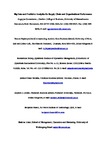Big data and predictive analytics for supply chain and organizational performance
| dc.contributor.author | Gunasekaran, A | |
| dc.contributor.author | Papadopoulos, T | |
| dc.contributor.author | Dubey, R | |
| dc.contributor.author | Wamba, SF | |
| dc.contributor.author | Childe, Stephen J | |
| dc.contributor.author | Hazen, B | |
| dc.contributor.author | Akter, S | |
| dc.date.accessioned | 2016-11-07T17:05:40Z | |
| dc.date.available | 2016-11-07T17:05:40Z | |
| dc.date.issued | 2017-01 | |
| dc.identifier.issn | 0148-2963 | |
| dc.identifier.issn | 1873-7978 | |
| dc.identifier.other | C | |
| dc.identifier.uri | http://hdl.handle.net/10026.1/6680 | |
| dc.description.abstract |
Scholars acknowledge the importance of big data and predictive analytics (BDPA) in achieving business value and firm performance. However, the impact of BDPA assimilation on supply chain (SCP) and organizational performance (OP) has not been thoroughly investigated. To address this gap, this paper draws on resource-based view. It conceptualizes assimilation as a three stage process (acceptance, routinization, and assimilation) and identifies the influence of resources (connectivity and information sharing) under the mediation effect of top management commitment on big data assimilation (capability), SCP and OP. The findings suggest that connectivity and information sharing under the mediation effect of top management commitment are positively related to BDPA acceptance, which is positively related to BDPA assimilation under the mediation effect of BDPA routinization, and positively related to SCP and OP. Limitations and future research directions are provided. | |
| dc.format.extent | 308-317 | |
| dc.language | en | |
| dc.language.iso | en | |
| dc.publisher | Elsevier | |
| dc.subject | Big data | |
| dc.subject | Assimilation | |
| dc.subject | Routinization | |
| dc.subject | Adoption | |
| dc.subject | Supply chain performance | |
| dc.subject | Firm performance | |
| dc.title | Big data and predictive analytics for supply chain and organizational performance | |
| dc.type | journal-article | |
| dc.type | Journal Article | |
| plymouth.author-url | https://www.webofscience.com/api/gateway?GWVersion=2&SrcApp=PARTNER_APP&SrcAuth=LinksAMR&KeyUT=WOS:000388053500032&DestLinkType=FullRecord&DestApp=ALL_WOS&UsrCustomerID=11bb513d99f797142bcfeffcc58ea008 | |
| plymouth.issue | C | |
| plymouth.volume | 70 | |
| plymouth.publication-status | Published | |
| plymouth.journal | Journal of Business Research | |
| dc.identifier.doi | 10.1016/j.jbusres.2016.08.004 | |
| plymouth.organisational-group | /Plymouth | |
| plymouth.organisational-group | /Plymouth/Faculty of Arts, Humanities and Business | |
| plymouth.organisational-group | /Plymouth/Faculty of Arts, Humanities and Business/Plymouth Business School | |
| plymouth.organisational-group | /Plymouth/REF 2021 Researchers by UoA | |
| plymouth.organisational-group | /Plymouth/REF 2021 Researchers by UoA/UoA17 Business and Management Studies | |
| plymouth.organisational-group | /Plymouth/Users by role | |
| plymouth.organisational-group | /Plymouth/Users by role/Academics | |
| dcterms.dateAccepted | 2016-07-16 | |
| dc.rights.embargodate | 2018-2-9 | |
| dc.identifier.eissn | 1873-7978 | |
| dc.rights.embargoperiod | Not known | |
| rioxxterms.versionofrecord | 10.1016/j.jbusres.2016.08.004 | |
| rioxxterms.licenseref.uri | http://www.rioxx.net/licenses/all-rights-reserved | |
| rioxxterms.licenseref.startdate | 2017-01 | |
| rioxxterms.type | Journal Article/Review |


